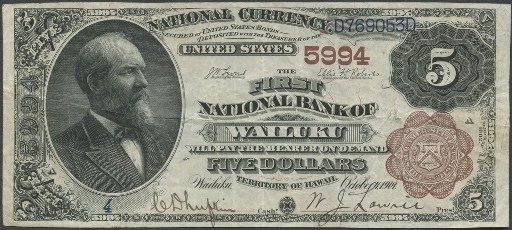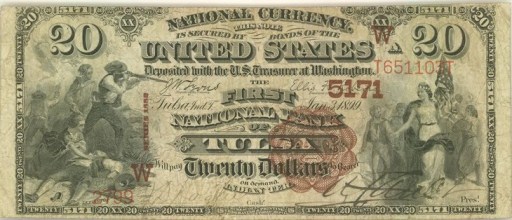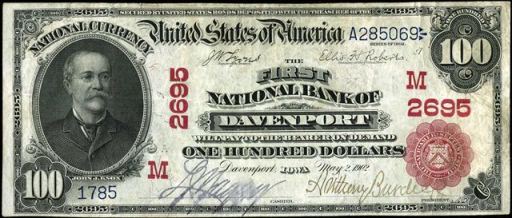The Minnehaha National Bank Of Sioux Falls
The Minnehaha National Bank Of Sioux Falls in South Dakota printed $658,450 dollars worth of national currency. That is a high amount, but condition and serial numbers can make otherwise common currency from this bank quite valuable. This national bank opened in 1885 and stopped printing money in 1935, which equals a 51 year printing period. That is considering a long operation period for a national bank. During its life, The Minnehaha National Bank Of Sioux Falls issued 8 different types and denominations of national currency. We have examples of the types listed below. Your bank note should look similar. Just the bank name will be different. For the record, The Minnehaha National Bank Of Sioux Falls was located in Minnehaha County. It was assigned charter number 3393.
We buy all national currency. Please call or email us for a quote. Sales@AntiqueMoney.com
The Minnehaha National Bank Of Sioux Falls in South Dakota issued 1,390 sheets of $5 1882 territorial brown back national bank notes. A total sheet output in the lows 1,000s is a great sign that you own a very rare bank note. 1882 five dollar territorial brown backs are the lifeblood of the territorial collecting community. They were issued by virtually every territory (with exception of Alaska, Nebraska, and Porto Rico). A total of 109 national banks printed $5 brown back territorials. There are around 120 notes known to exist. That is a pretty high survival rate. Ironically though, the fact that lots of these exist is part of the reason that they are so collectible. More than one collector can reasonably try to put together a set. Ultra-rarities are always expensive, but often times they end up as outliers to collections. 1882 five dollar brown backs have always been popular. When you combine that with the appeal of a territorial, then you have a real winner. You can contact us to learn the true value and rarity of your note. In the meantime, take the number of sheets printed and multiply it by four, that will give you the total number of 1882 $5 territorials issued.
Series of 1882 $5 Territorial Brown Back
The Minnehaha National Bank Of Sioux Falls printed 1,390 sheets of $20 1882 territorial brown back national bank notes. That number also represents the total number of twenty dollar bills printed for the type. Whether you have a ten or a twenty dollar territorial brown back, you should work with an expert to establish the value. Twenty dollar notes from this series were only printed at the rate of one to three compared to tens, but sadly, $20 1882 brown backs really don’t command a premium for their extra rarity. Only around fifty are known to exist today.
Series of 1882 $20 Territorial Brown Back
The Minnehaha National Bank Of Sioux Falls also printed 4,374 sheets of $10 1882 brown back national bank notes. That it is not an exceptionally low number of sheets. However, you have to remember that we are talking about bank notes printed before 1902. Even a large print number could have a very low survival rate. There were three $10 bills printed on a single sheet of 1882 brown backs. The design of the bill is similar to all earlier ten dollar national bank notes. The nickname comes from the fact that these bills have a brown seal and brown overprint. Despite saying series of 1882, these were actually printed by some banks up until 1908. The date you see in cursive relates to when the bank first started issuing brown back notes.
Series of 1882 $10 Brown Back
The Minnehaha National Bank Of Sioux Falls also printed 4,374 sheets of $20 1882 brown back national bank notes. As you can see, the sheet output is the same for $20 brown backs as it is for $10 brown backs. There was only one $20 brown back printed on a sheet. So the sheet output also equals the total note output. One neat thing about all brown backs is that they each have a different back design based on which state issued them. The back left hand side of the note shows the state seal of which ever state the national bank was located in. Generally speaking, 1882 $20 brown backs are pretty difficult to locate. They typically were printed in small numbers and they don’t have a great survival rate.
Series of 1882 $20 Brown Back
The Minnehaha National Bank Of Sioux Falls also printed 1,025 sheets of $50 1902 red seal national bank notes. That is also the exact number of $50 red seals printed by this bank. Each sheet contained one $50 bill and one $100 bill. They are all extremely rare. The value for a generic circulated example is usually around $4,000. Most are worth more and some can be worth considerably more. John Sherman is pictured on each note. Otherwise it has the same markings you would expect to find on any 1902 red seal.
1902 $50 Red Seal National Bank Note
The Minnehaha National Bank Of Sioux Falls also printed 1,025 sheets of $100 1902 red seal national bank notes. As we said above, all high denomination 1902 red seals are extremely rare. The number of notes printed really doesn’t matter to collectors. 1902 $100 red seals are rare to the point that they are always in demand. Of course the standard valuation rules still apply. Condition and bank of issue are of paramount importance. We have paid over $12,000 for some of the rarest specimens.
1902 $100 Red Seal National Bank Note
The Minnehaha National Bank Of Sioux Falls also printed 784 sheets of $50 1902 blue seal national bank notes. There is no trick to knowing which 1902 blue seals will be common and rare. Often times the number printed won’t tell you much information. The value still comes down to condition and demand. That is a surprise to most people. In fact, most 1902 $50 bills we see are worth between $750 and $1,250. The rarer ones can be worth more than $5,000. However, there isn’t much middle ground.
1902 $50 Blue Seal National Bank Note
The Minnehaha National Bank Of Sioux Falls also printed 784 sheets of $100 1902 blue seal national bank notes. It is no coincidence that the sheet numbers for $50 bills and $100 bills are the same. They were printed on the same sheets. Most $100 blue seals are at least scarce; others can be very rare. John J Knox is printed on the front of each bill. Most collectors like the back design a lot more though. It is really unique and different from most other national bank notes. Prices for 1902 $100 blue seals are pretty similar to $50 blue seals. They are both equally common or equally rare, depending on how you look at it.
1902 $100 Blue Seal National Bank Note



